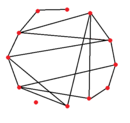Hubs are bigger than other nodes
Average degree = 2.833
Average shortest path length = 2.109.
Clustering coefficient = 0.167
| Part of a series on | ||||
| Network science | ||||
|---|---|---|---|---|
| Network types | ||||
| Graphs | ||||
|
||||
| Models | ||||
|
||||
| ||||
A small-world network is a graph characterized by a high clustering coefficient and low distances. On an example of social network, high clustering implies the high probability that two friends of one person are friends themselves. The low distances, on the other hand, mean that there is a short chain of social connections between any two people (this effect is known as six degrees of separation).[1] Specifically, a small-world network is defined to be a network where the typical distance L between two randomly chosen nodes (the number of steps required) grows proportionally to the logarithm of the number of nodes N in the network, that is:[2]
while the global clustering coefficient is not small.
In the context of a social network, this results in the small world phenomenon of strangers being linked by a short chain of acquaintances. Many empirical graphs show the small-world effect, including social networks, wikis such as Wikipedia, gene networks, and even the underlying architecture of the Internet. It is the inspiration for many network-on-chip architectures in contemporary computer hardware.[3]
A certain category of small-world networks were identified as a class of random graphs by Duncan Watts and Steven Strogatz in 1998.[4] They noted that graphs could be classified according to two independent structural features, namely the clustering coefficient, and average node-to-node distance (also known as average shortest path length). Purely random graphs, built according to the Erdős–Rényi (ER) model, exhibit a small average shortest path length (varying typically as the logarithm of the number of nodes) along with a small clustering coefficient. Watts and Strogatz measured that in fact many real-world networks have a small average shortest path length, but also a clustering coefficient significantly higher than expected by random chance. Watts and Strogatz then proposed a novel graph model, currently named the Watts and Strogatz model, with (i) a small average shortest path length, and (ii) a large clustering coefficient. The crossover in the Watts–Strogatz model between a "large world" (such as a lattice) and a small world was first described by Barthelemy and Amaral in 1999.[5] This work was followed by many studies, including exact results (Barrat and Weigt, 1999; Dorogovtsev and Mendes; Barmpoutis and Murray, 2010).
- ^ Downey, Allen B. (2016). "3". Think Complexity (PDF). Needham, Massachusetts: Green Tea Press. p. 27.
- ^ Watts DJ, Strogatz SH (June 1998). "Collective dynamics of 'small-world' networks". Nature. 393 (6684): 440–2. Bibcode:1998Natur.393..440W. doi:10.1038/30918. PMID 9623998. S2CID 4429113.
- ^ Kundu S, Chattopadhyay S (2014). Network-on-chip: the Next Generation of System-on-Chip Integration (1st ed.). Boca Raton, FL: CRC Press. ISBN 9781466565272. OCLC 895661009.
- ^ Watts DJ, Strogatz SH (June 1998). "Collective dynamics of 'small-world' networks". Nature. 393 (6684): 440–2. Bibcode:1998Natur.393..440W. doi:10.1038/30918. PMID 9623998. S2CID 4429113.
- ^ Barthelemy M, Amaral LA (1999). "Small-world networks: Evidence for a crossover picture". Physical Review Letters. 82 (15): 3180–3183. arXiv:cond-mat/9903108. Bibcode:1999PhRvL..82.3180B. doi:10.1103/PhysRevLett.82.3180. S2CID 119398712.



